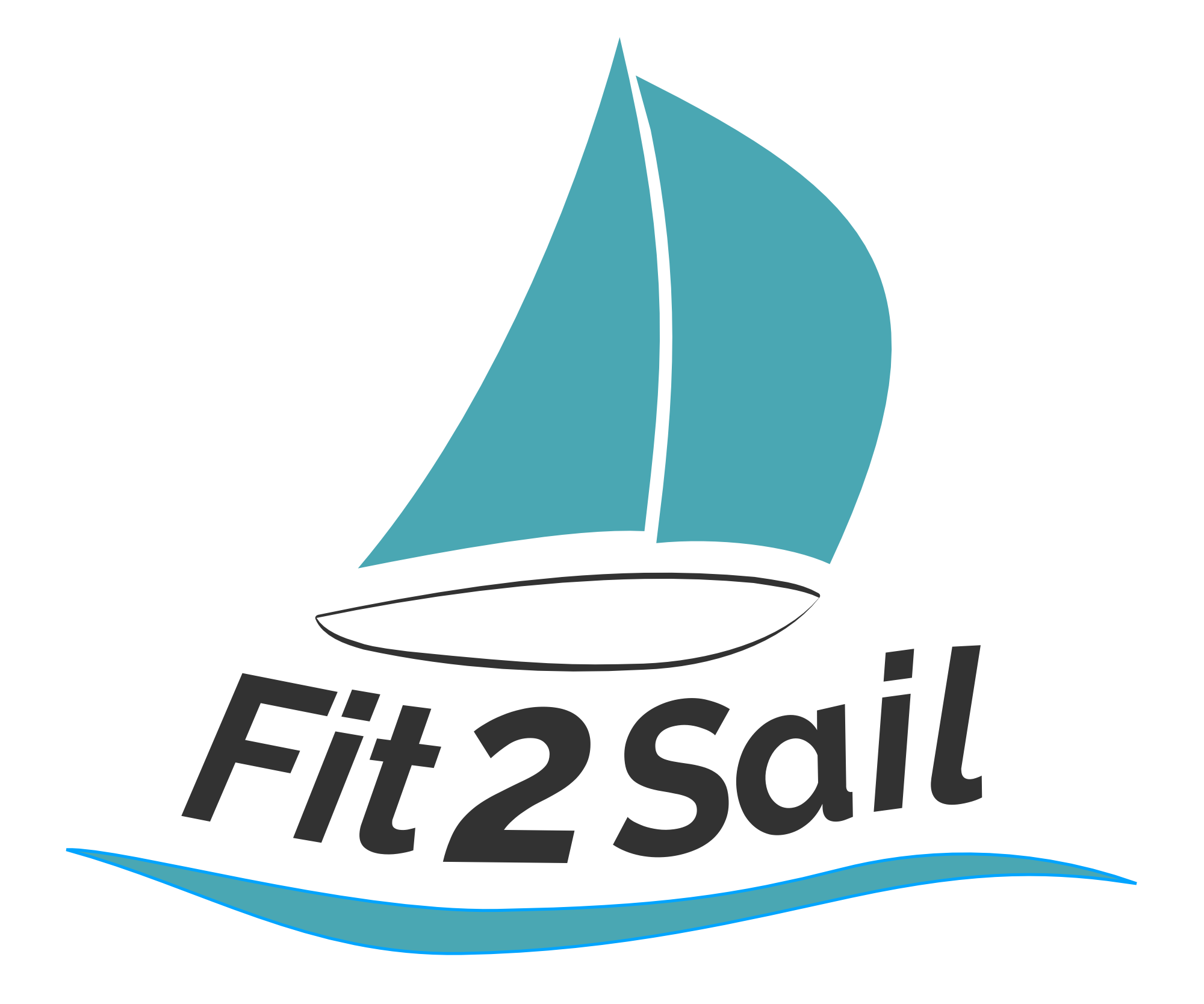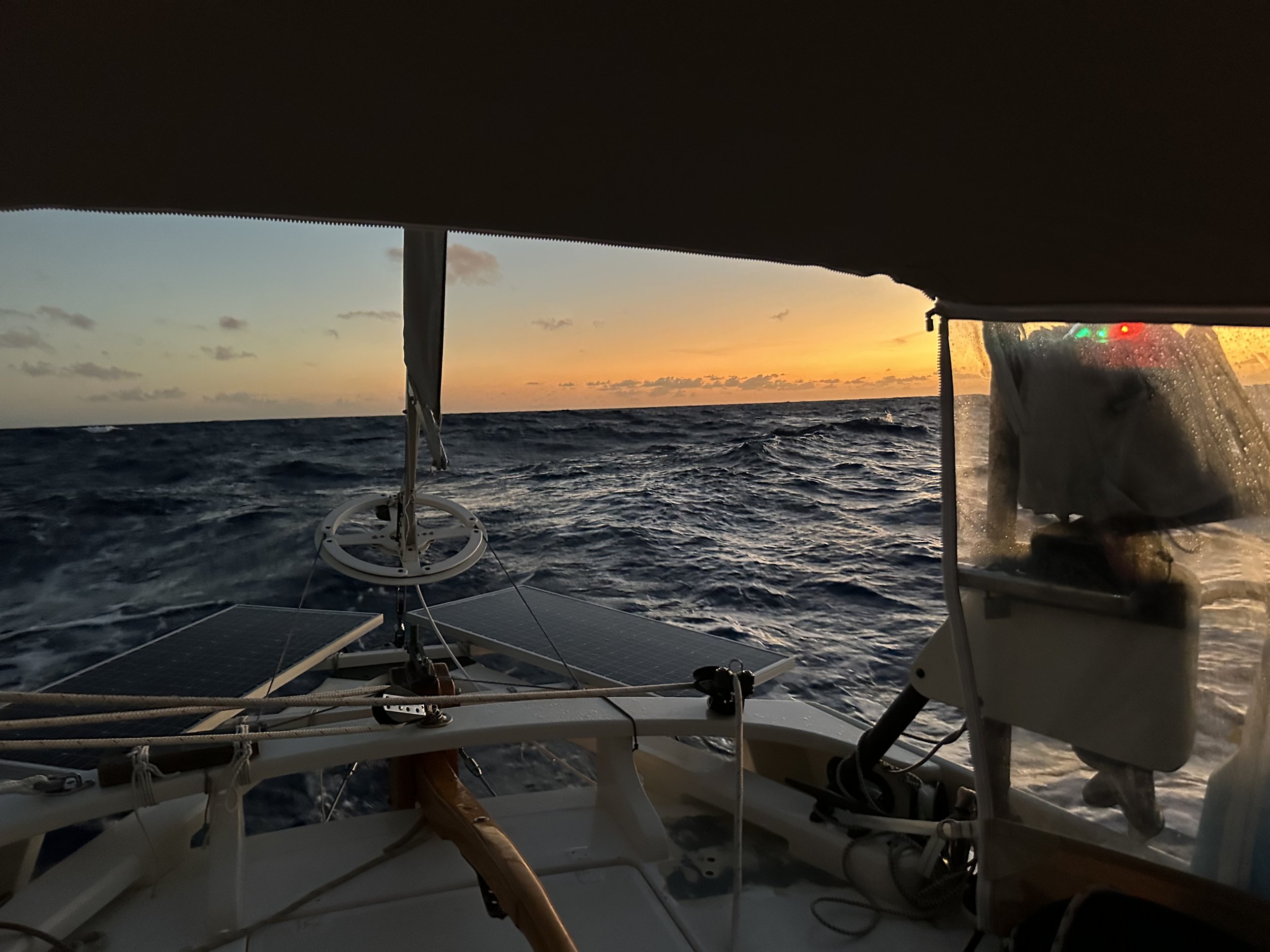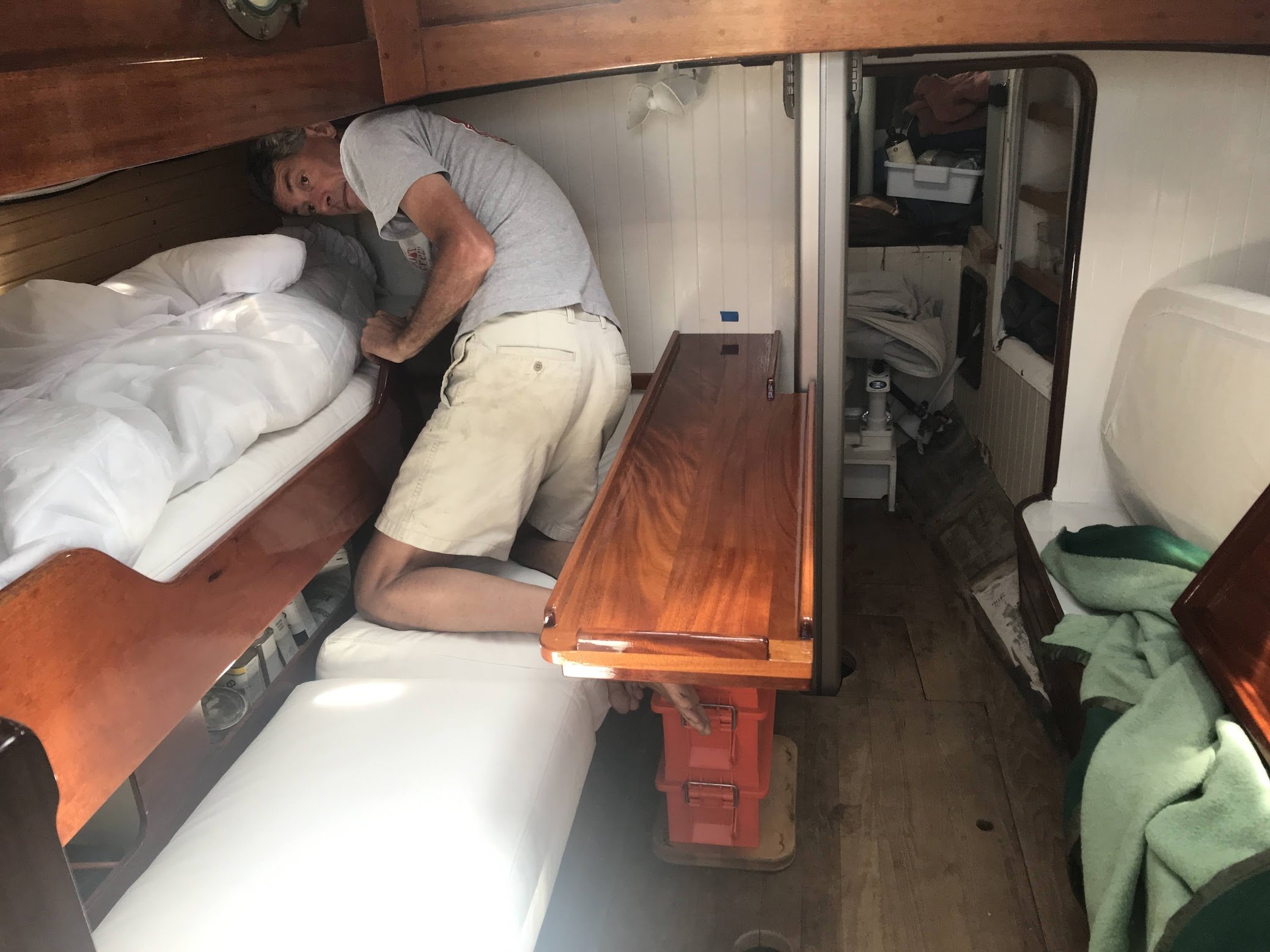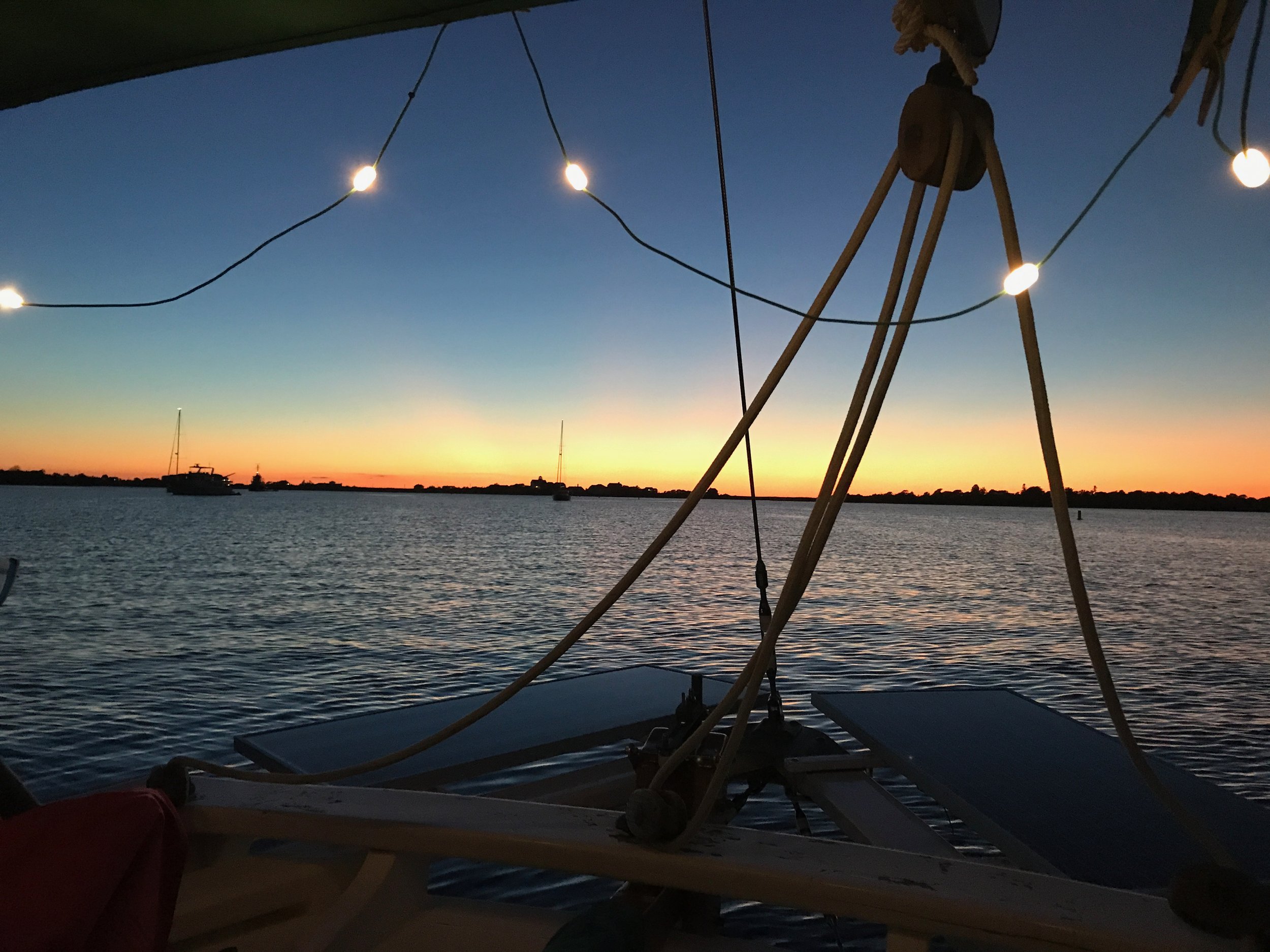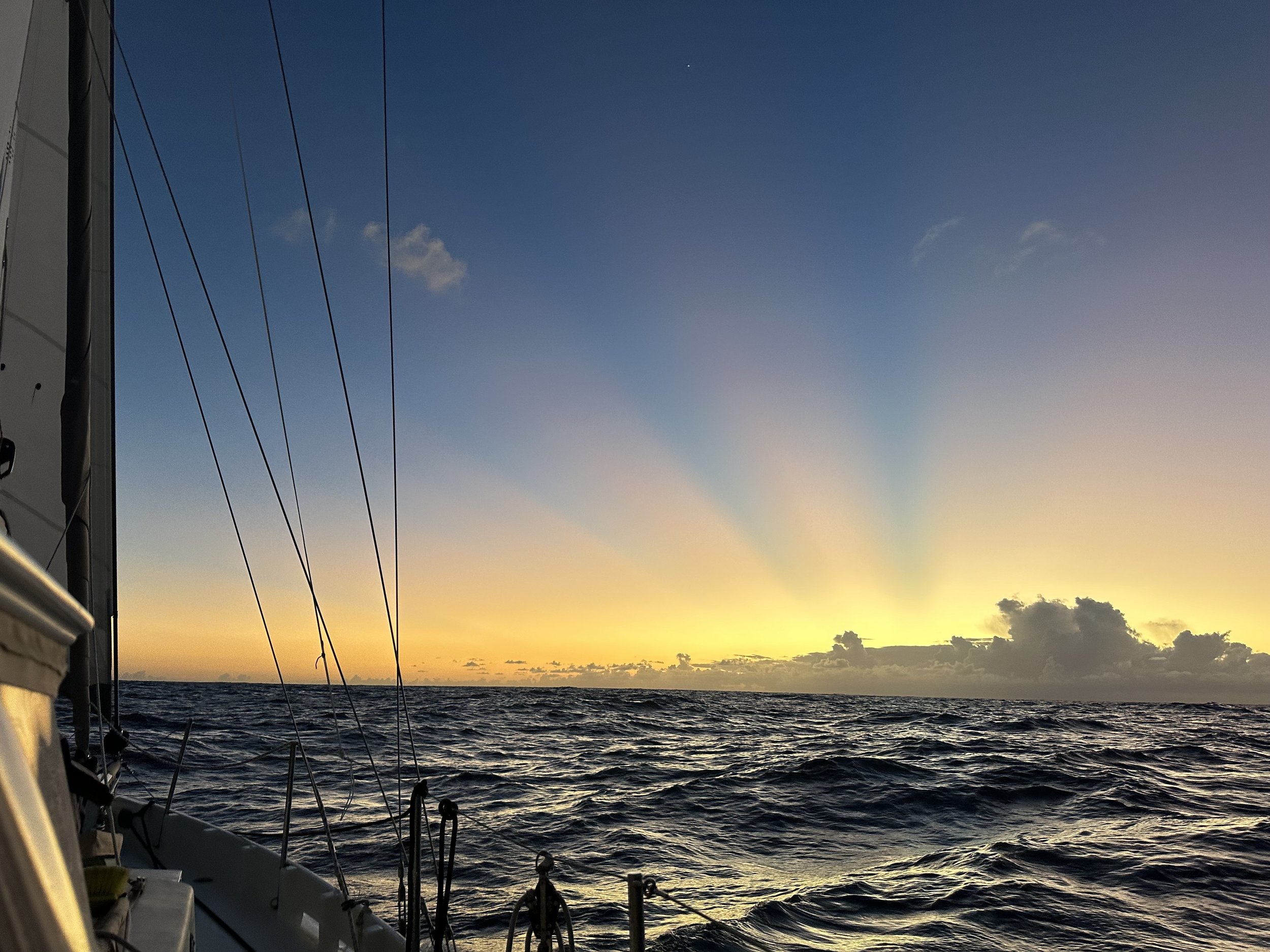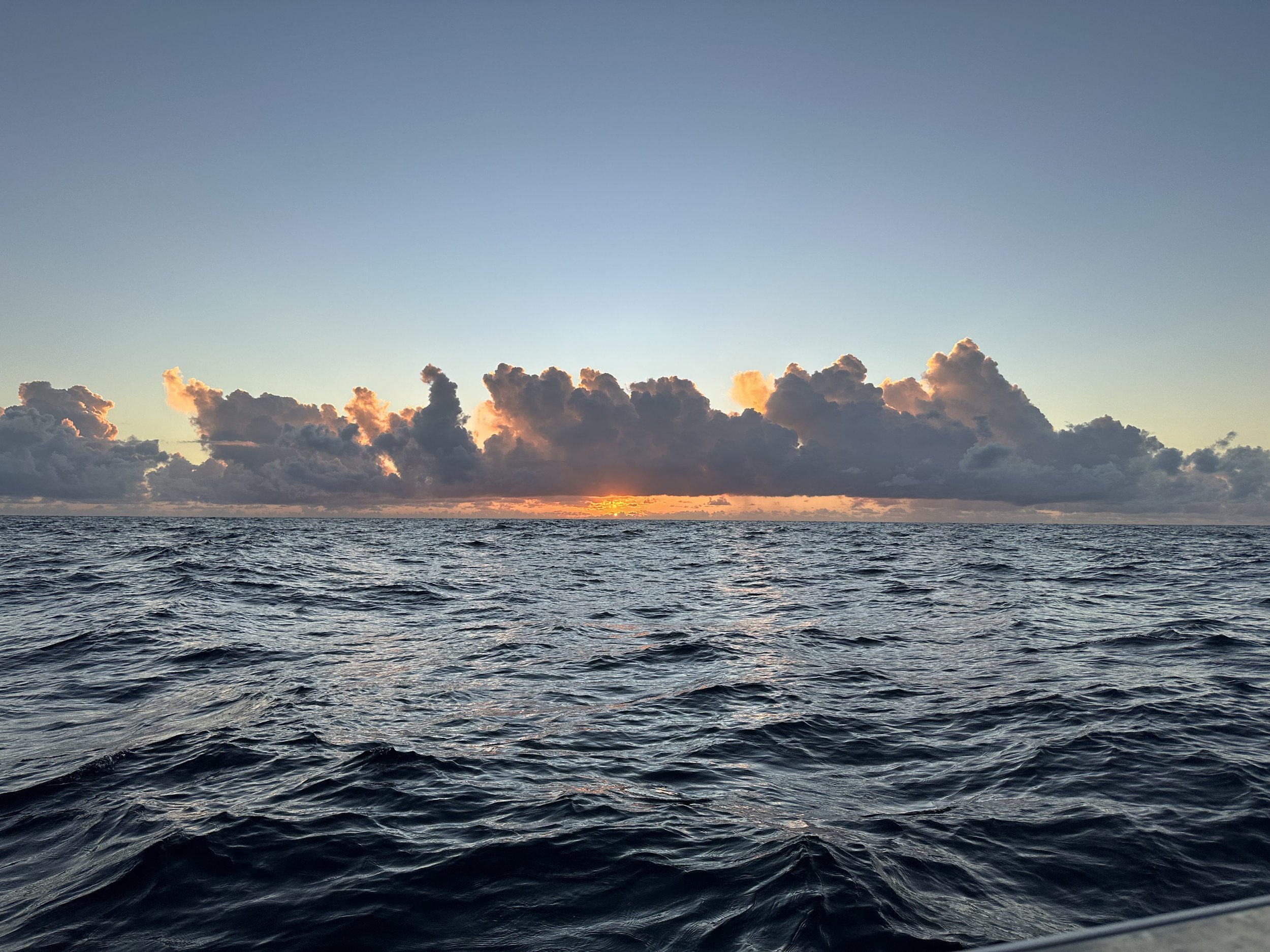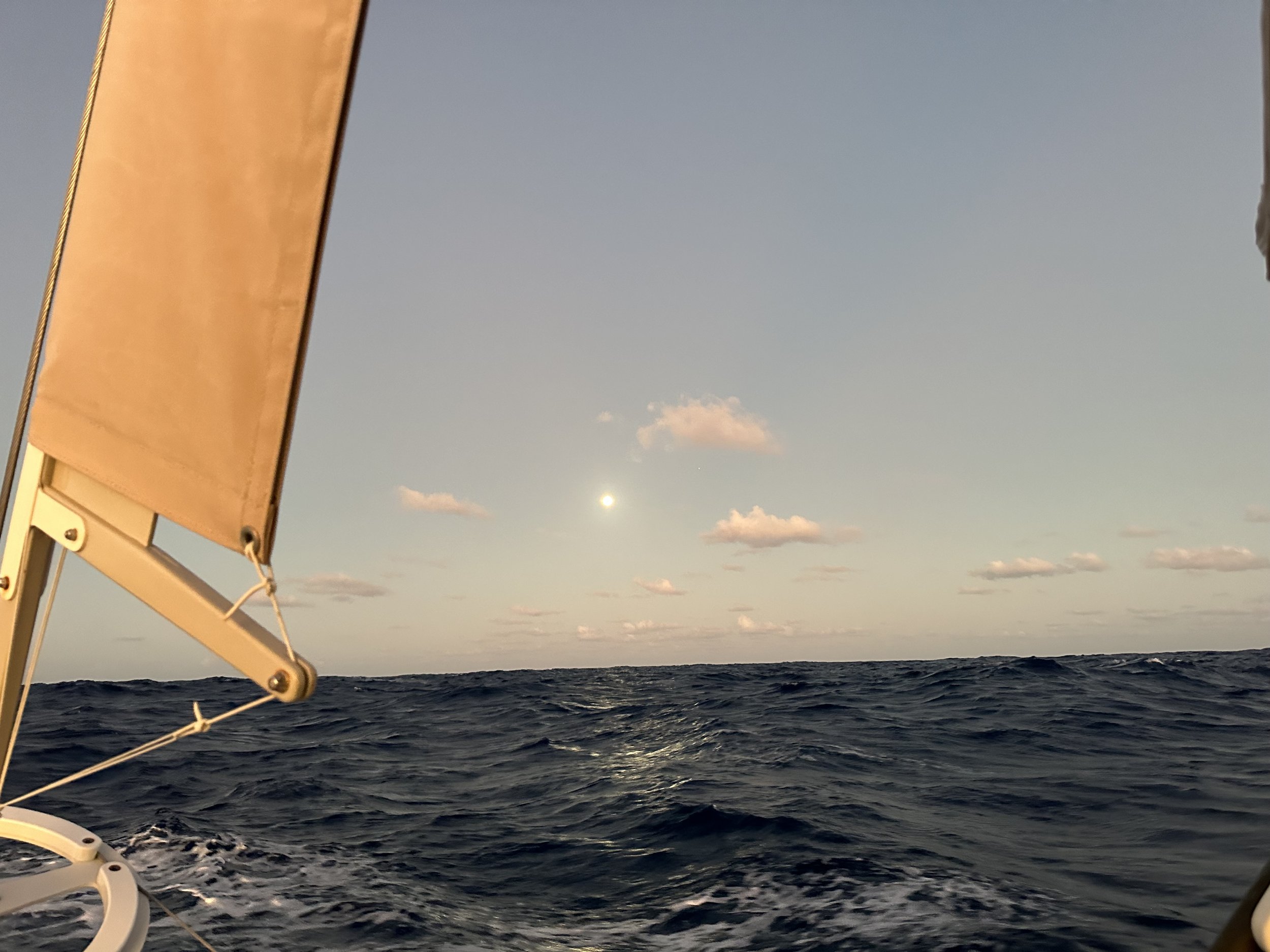Passage Rhythms
Do you really sail all night long? What do you do?
A 24 hour glimpse into life aboard, as evidenced on our recent 800 mile passage across the Caribbean Sea from Great Inagua, Bahamas, to Porvenir, Panama.
Cuba to starboard, our first evening on passage
0600. Sun isn’t officially up yet, but there’s enough twilight to see everything with ease. Watching the light filter down from the clouds is wild. If I wanted a cup of coffee now, there would be no flashlight required. Last night was kind of hilarious, actually, bringing the coffee mug over to the red chart table light to see just how much I’d already poured myself. It took 3 iterations before I was satisfied. It’s rolly enough that I didn’t want to pour coffee into the mug somewhere other than the sink; if it spills in the sink there’s no harm. Hence the trips from sink to chart table, an onerous trek of 2 feet.
The wind has bent around the tip of Haiti, pushing us more west than south. We need to take the pole down to come up a bit, but that task can wait until Jeremy gets up in half an hour or so. No sense in waking him up with noise.
Morning twilight
0800. I roll myself out of the bunk to check mileage and record our 24 hour run, a blistering 165 nm (almost 7 knots average speed). We’re not likely to repeat that on this passage but it’s nice to dream.
We’d set up the quarterberth especially for this passage, but until we get more fans installed it’s a bit stuffy in there, plus the sheets are too big and slide around. Not a fan of slidey sheets. I started my offwatch on the starboard side settee but switched to our bunk, fan blasting right on me. As long as the heel isn’t too intense that’s a good option. The bunkboard holds me in. It’s comfy with our mattress pad and sheets, breezy with the fan even though we can’t open the hatch, and big enough for stomach sleeping. I definitely sleep better there than on the settee. Plus if Jeremy needs to use the head he’s not in any danger of brushing past me.
bunk in construction time, bedding and bunkboard visible
1100. Jeremy’s getting weather, a combination of Chris’s forecast (not especially useful, frankly, for any non-coastal work) as well as more specific point forecasts through FastSeas. He’s set up the InReach to be able to ripple lengthy mails and is about to start fussing with hooking up the SSB to get GRIBs.
Jeremy getting weather via the SSB
We’re further along than we’d expected to be - a good thing - but still want to avoid the reach of what we’re calling the “plume”, a swath of blasting wind that races through the Windward Passage southwestward towards Jamaica. If we can avoid 35 knot sustained winds we’d prefer that for sure.
plume visible on a screenshot
Regardless of whether we manage to escape the tentacles of the plume or not, what seems to be apparent is that it’ll be bumpier later on. It might be a good idea to get food prep done early, and all the dish washing.
1200. Jeremy starts up the water maker. First we fill the shower, then switch to adding water to the tanks.
Our water maker, a small desalination machine, makes fresh water from salt. This one was a hand-me-down from a former colleague in Charlottesville when they switched to one with more capacity on their much larger boat. It makes 3 gallons an hour and runs on 12 volts, meaning we can easily power it with our solar panels charging the batteries. Many of the newer, more powerful/higher capacity machines, require the use of a generator to operate.
The pump for the watermaker
1300. Lunch is a very fancy affair. (insert sarcasm emoji) Slice the last of the homemade rolls, insert ham, hand up to the cockpit. Eat with water swigged out of Nalgene bottles, complete with spills down the front of shirts as the boat heaves from side to side.
1400. Jeremy’s down for a quick snooze while I chop veggies for a version of Deli Chicken (a curry and BBQ flavor combination), though this one will involve a can of pinto beans and one of home-canned pork chunks. There goes the last of the carrots from GeorgeTown, the last pepper. Still lots of onions and garlic left from Florida.
Chopping takes some patience. I’ve got my right hip wedged between the ladder and the counter, with a cutting board perched over the sink. The pressure cooker (since it’s got the highest sides) is on the stove, swinging with the boat. There’s a bowl in the sink ready to receive the chopped stuff. I cut an onion in half, then quickly put the cut side down so it doesn’t roll off while I deal with peeling and cutting the other half. Detritus is swept into the sink (away from the bowl) for the time being.
The sink is the ultimate catch-all. It’s a good thing it’s big.
So. Much. Space!
1500. Dishwashing time. First, of course, I need to clear out the sink of anything NOT dishes, so the veggie scraps go into the bowl to toss overboard. Luckily all that needs washing is the coffee stuff from earlier and the couple of prep utensils.
Calypso’s water system is foot-pump based, with no hot water unless we involve the stove and a pot. This makes washing dishes with minimal water very easy; water runs only when we’re actively making it run.
I lay out the dish drying mat to have someplace to put stuff after it’s washed, then grab a clean dish towel to dry everything and put it away. Luckily we’re on a port tack, meaning if anything slides it gets caught on the cabinet doors, not getting launched into the main salon.
Old shot of Jeremy washing dishes, drying mat visible to right
1530. Shower time.
Our shower is essentially a pump up garden sprayer, though this one is marketed as a camping shower. The 2-gallon size affords a good shower for both of us as long as we wash hair on separate days. Leaving it in the sun, as long as it’s not too windy, is an easy way to get hot water, though that takes some foresight especially if we’ve just run the water maker. It’s chilly enough today that we heat a pot of water on the stove to add in, warming up the shower water. As long as you remember to shake the shower before spraying, the warm water mixes with the cooler stuff and it’s a great temperature.
Usually, we shower every day, even on passage.
Shower at sea!
All clean
1715. There goes the sun!
Will there be a green flash?
1800. Dinner time. I cook the rice, heat up the made-earlier-stew, and serve it up in the wide stoneware bowls that were wedding presents from my great aunt and uncle. The blue-and-grey glazed pattern makes me smile every time.
We eat in the cockpit, Luci lights twinkling.
Luci lights at anchor
1900. Dishes have been washed and put away, the stovetop is cleaned. The ritualistic toothbrushing party is complete. I change into pjs and climb into our bunk. I’ll read for a bit on my kindle before closing my eyes.
Our watch schedule is more formal at night, less formal during the day. Generally, Jeremy takes the first watch, starting after dinner and going until midnight or 1 am. Then I come on until dawn or until he wakes up with the sun. Since either Larry (the wind vane) or the Droid (the electric autopilot) is steering, watches consist of a really good look around every 12-15 minutes and otherwise reading or listening to podcasts or music, or even catnapping. This 15 minute “take a good look around” interval is one we follow even in bright daylight.
1230. “Hey. Time to get up.” Jeremy shakes me gently. “We need to gybe to stay on course, so let’s do that now.” I get out of bed, change into regular clothes, and put my harness on in the cockpit. Furl the jib on the pole, go on deck to release the preventer, change course as we pull in the main then let it out on the new tack. Back on deck to change the pole to the other side. We’re settled onto the new course, Larry steering well. Jeremy gives me a kiss and heads down for his off watch.
sunset with poled out jib
0100-sunrise passes smoothly. I’m engrossed in David McCullough’s Path Between the Seas, with accounts of horrible yellow fever outbreaks punctuated by fascinating glimpses of charismatic personalities and vivid details of the challenges of building the Panama Canal. My alarm goes off every 13 minutes, reminding me to stand up and look around carefully, checking our course, the sails, the horizon. Before I sit back down and set the alarm again, I do 10 squats and 10 pushups against the companionway. At some point my focus wanes, so I switch from reading to music, dancing in the cockpit in a solitary, moonlit display of joy and abandon.
Moonlight through the clouds
When Jeremy comes up, I’m ready for sleep.
Sunset at sea
Sunrise at sea
Full moon at sunset, Larry steering
Land ho!
Our passage, 780 miles across the Caribbean Sea, took us almost exactly 6 days from anchor up to anchor down.
